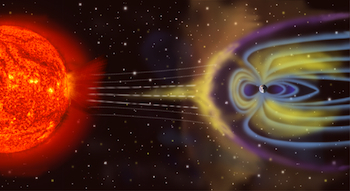The Solar Wind and Auroras
A continuous flow of charged particles (ions and electrons) from the Sun is discharged as a solar wind. At these extremely high temperatures, violent collisions of gases strip charged particles of electrons, and acquire enough speed to escape the gravitational pull of the Sun. As the solar wind streaks toward Earth the flow of particles strikes the Earth's magnetic field deforming it into a tear-drop shaped cavity called the magnetosphere. Inside the magnetosphere are ionized gases from the solar wind and the upper most part of the Earth's atmosphere.

Figure 2.5 Magnetosphere shielding the Earth from the solar wind. Courtesy NASA
During periods of high solar activity, the solar wind is more dense, travels faster, and possesses more energy. Reaching the Earth's magnetic field it sets off amazing displays of light by exciting atmospheric gases. In the Northern Hemisphere the spectacular light shows are called the aurora borealis or northern lights. In the Southern Hemisphere they are called the aurora australis, or southern lights. Solar flares have a direct impact on modern society. They create geomagnetic storms that deposit excess energy on power grids and satellite components causing them to fail. Solar flares disrupt cell phone communication, television signals from satellites, corrode pipelines and disrupt global positioning systems. They also pose a radiation threat to astronauts orbiting in space.
Video: The Mystery of
the Aurora
Courtesy NASAexplorer
